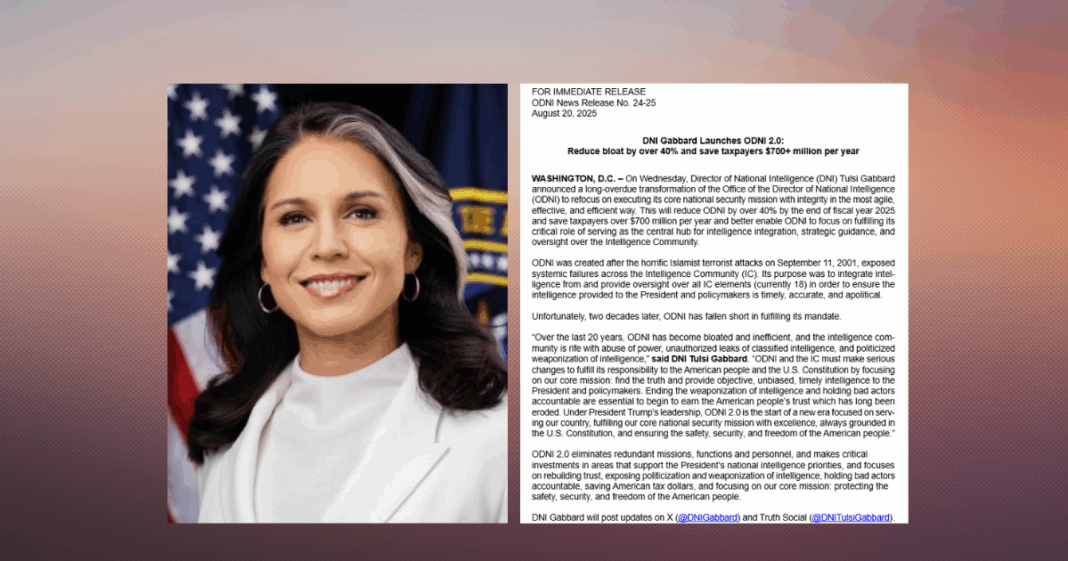Director of National Intelligence Tulsi Gabbard announced Wednesday, 20 August 2025, that she is directing a sweeping reform of the Office of the Director of National Intelligence that will eliminate a number of centers and reduce staffing levels by over 40% by the end of fiscal year 2025.
The initiative, dubbed “ODNI 2.0,” aims to cut what Gabbard described as redundant functions and save taxpayers more than $700 million annually. The restructuring affects several intelligence centers and eliminates approximately 500 positions that have already been removed from ODNI’s roster.
Major Changes
According to the release, the restructuring eliminates or significantly reduces several intelligence centers:
Foreign Malign Influence Center (FMIC) will be dissolved, with Gabbard citing redundancy with existing functions in the National Intelligence Council and National Counterintelligence and Security Center. The DNI said FMIC had developed inappropriate relationships with social media companies and was involved in content moderation decisions, including actions related to the Hunter Biden laptop story in October 2020.
National Counterproliferation and Biosecurity Center (NCBC) will be significantly reduced, with weapons proliferation monitoring transferred to the National Intelligence Council. The center had expanded its scope to global health issues during the COVID-19 pandemic, which Gabbard said fell outside ODNI’s core mission.
Cyber Threat Intelligence Integration Center (CTIIC) will be eliminated, with cyber intelligence functions moving to the National Intelligence Council.
The National Intelligence University will be merged with the National Defense University, with current students transitioning to other institutions to complete their programs.
Two advisory groups, the External Research Council and Strategic Futures Group, are being eliminated entirely. Gabbard described these as vehicles for “partisan priorities” in intelligence products.
Financial Impact
The restructuring is projected to save $700 million annually through various cuts:
- FMIC elimination: $7 million per year
- NCBC reduction: $29 million per year
- CTIIC elimination: $10 million per year
- NIU merger: $40 million per year
Additional savings will come from eliminating what officials described as duplicative contracts and staff across all 18 intelligence community elements, totaling approximately $1.3 billion in annual recurring costs.
Operational Changes
ODNI will close its Reston campus and consolidate the National Intelligence Council at the main ODNI campus. The move is intended to improve oversight and integration across intelligence functions.
Gabbard also announced changes to acquisition processes to accelerate technology purchases and issued guidance for streamlined contracting with companies already approved for intelligence community work.
Background and Rationale
ODNI was created in 2004 following the September 11, 2001 attacks to integrate intelligence from 18 different agencies and provide oversight of the intelligence community. Gabbard said the office had become “bloated” and “distracted by tasks and requirements that fall outside its mandate.”
The DNI specifically criticized what she termed the “weaponization” of intelligence and unauthorized leaks of classified information. She said the intelligence community had become plagued with “politicization” that undermined its core mission.
“ODNI and the IC must make serious changes to fulfill its responsibility to the American people and the U.S. Constitution by focusing on our core mission: find the truth and provide objective, unbiased, timely intelligence to the President and policymakers,” Gabbard said in a statement.
The restructuring represents one of the most significant changes to the intelligence community structure since ODNI’s creation two decades ago. Implementation is expected to be completed by the end of fiscal year 2025.
A global media for the latest news, entertainment, music fashion, and more.















